This article has multiple issues. Please help improve it or discuss these issues on the talk page . (Learn how and when to remove these template messages)
|
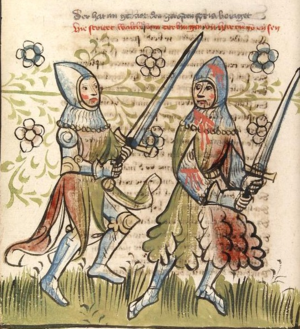
Walter or Walther of Aquitaine is a king of the Visigoths in Germanic heroic legend.
This article has multiple issues. Please help improve it or discuss these issues on the talk page . (Learn how and when to remove these template messages)
|

Walter or Walther of Aquitaine is a king of the Visigoths in Germanic heroic legend.
Walter figures in several epic poems and narratives dealing with Germanic heroic legend in medieval languages:
The most complete poem specifically about Walter is Waltharius , in which Walter fights single-handedly against the Burgundian king Gunther and his retinue, killing all attackers except for Gunther and Hagen. In later literature, Walter figures in Scheffel's novel Ekkehard (1887).
Walter is not a historical king, but the historical nucleus of his legend lies in the 5th century (the reign of the Balti dynasty), after king Wallia established a Visigothic kingdom in Aquitaine in 417, clashing with the Vandals under king Gunderic. The Burgundians became neighbours of the Visigoths after being resettled to Savoy by Flavius Aëtius in 443 during the rule of Gunderic of Burgundy.

The Burgundians were an early Germanic tribe or group of tribes. They appeared in the middle Rhine region, near the Roman Empire, and were later moved into the empire, in the western Alps and eastern Gaul. They were possibly mentioned much earlier in the time of the Roman Empire as living in part of the region of Germania that is now part of Poland.
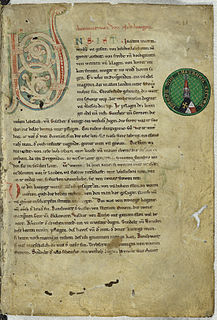
The Nibelungenlied, translated as The Song of the Nibelungs, is an epic poem written around 1200 in Middle High German. Its anonymous poet was likely from the region of Passau. The Nibelungenlied is based on an oral tradition of Germanic heroic legend that has some of its origin in historic events and individuals of the 5th and 6th centuries and that spread throughout almost all of Germanic-speaking Europe. Scandinavian parallels to the German poem are found especially in the heroic lays of the Poetic Edda and in the Völsunga saga.

Brunhild, also known as Brunhilda or Brynhild, is a female character from Germanic heroic legend. She may have her origins in the Visigothic princess Brunhilda of Austrasia.
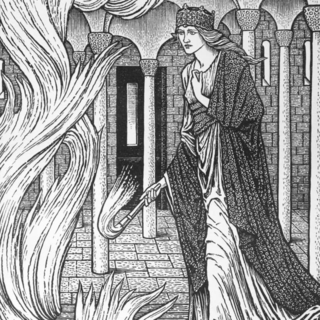
Gudrun or Kriemhild is the wife of Sigurd/Siegfried and a major figure in Germanic heroic legend and literature. She is believed to have her origins in Ildico, last wife of Attila the Hun, and two queens of the Merovingian dynasty, Brunhilda of Austrasia and Fredegund.

Wallia or Walha, was king of the Visigoths from 415 to 418, earning a reputation as a great warrior and prudent ruler. He was elected to the throne after Athaulf and then Sigeric were assassinated in 415.

Gundaharius or Gundahar, better known by his legendary names Gunther or Gunnar, was a historical king of Burgundy in the early 5th century. Gundahar is attested as ruling his people shortly after they crossed the Rhine into Roman Gaul. He was involved in the campaigns of the failed Roman usurper Jovinus before the latter's defeat, after which he was settled on the left bank of the Rhine as a Roman ally. In 436, Gundahar launched an attack from his kingdom on the Roman province of Belgica Prima. He was defeated by the Roman general Flavius Aetius, who destroyed Gundahar's kingdom with the help of Hunnish mercenaries the following year, resulting in Gundahar's death.

Walter is a German masculine given name derived from Old High German Walthari, composed of the elements walt- "power", "brightness", "forest", and hari "warrior".
The term Nibelung (German) or Niflungr is a personal or clan name with several competing and contradictory uses in Germanic heroic legend. It has an unclear etymology, but is often connected to the root nebel, meaning mist. The term in its various meanings gives its name to the Middle High German heroic epic the Nibelungenlied.
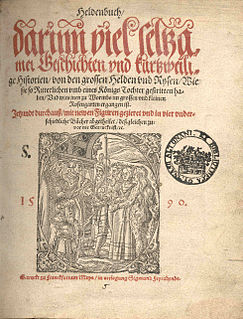
Heldenbücher is the conventional title under which a group of German manuscripts and prints of the 15th and 16th centuries has come down to us. Each Heldenbuch contains a collection of primarily epic poetry, typically including material from the Theodoric cycle, and the cycle of Hugdietrich, Wolfdietrich and Ortnit. The Heldenbuch texts are thus based on medieval German literature, but adapted to the tastes of the Renaissance.

Waltharius is a Latin epic poem founded on German popular tradition relating the exploits of the Visigothic hero Walter of Aquitaine. While its subject matter is taken from early medieval Germanic legend, the epic stands firmly in the Latin literary tradition in terms of its form and the stylistic devices used. Thus, its 1456 verses are written in dactylic hexameter and the poem includes copious references to various Latin epics of antiquity, especially Vergil's Aeneid.

Der Rosengarten zu Worms, sometimes called Der große Rosengarten to differentiate it from Der kleine Rosengarten (Laurin), and often simply called the Rosengarten, is an anonymous thirteenth-century Middle High German heroic poem in the cycle of Dietrich von Bern. The Rosengarten may have been written as early as before 1250, but is securely attested by around 1300. It is unclear where it was written.
"Waldere" or "Waldhere" is the conventional title given to two Old English fragments, of around 32 and 31 lines, from a lost epic poem, discovered in 1860 by E. C. Werlauff, Librarian, in the Danish Royal Library at Copenhagen, where it is still preserved. The parchment pages had been reused as stiffening in the binding of an Elizabethan prayer book, which had presumably come to Europe following the Dissolution of the Monasteries in England in the 16th century.

Ekkehard I, called Major or Senex, was a monk of the Abbey of Saint Gall. He was of noble birth, of the Jonschwyl family in Toggenburg, and was educated in the monastery of St. Gall; after joining the Benedictine Order, he was appointed director of the inner school there. Later, under Abbot Kralo, who trusted him implicitly, he was elected dean of the monastery, and for a while directed all the affairs of the abbey.
The GermanicHeroic Age, so called in analogy to the Heroic Age of Greek mythology, is the period of early historic or quasi-historic events reflected in Germanic heroic poetry.
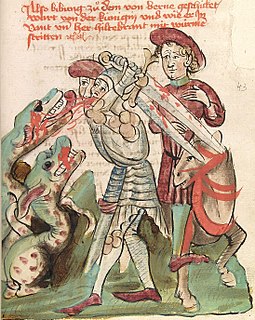
Dietrich von Bern is the name of a character in Germanic heroic legend who originated as a legendary version of the Ostrogothic king Theodoric the Great. The name "Dietrich", meaning "Ruler of the People", is a form of the Germanic name "Theodoric". In the legends, Dietrich is a king ruling from Verona (Bern) who was forced into exile with the Huns under Etzel by his evil uncle Ermenrich. The differences between the known life of Theodoric and the picture of Dietrich in the surviving legends are usually attributed to a long-standing oral tradition that continued into the sixteenth century. Most notably, Theodoric was an invader rather than the rightful king of Italy and was born shortly after the death of Attila and a hundred years after the death of the historical Gothic king Ermanaric. Differences between Dietrich and Theodoric were already noted in the Early Middle Ages and led to a long-standing criticism of the oral tradition as false.

Germanic heroic legend is the heroic literary tradition of the Germanic-speaking peoples, most of which originates or is set in the Migration Period. Stories from this time period, to which others were added later, were transmitted orally, traveled widely among the Germanic speaking peoples, and were known in many variants. These legends typically reworked historical events or personages in the manner of oral poetry, forming a heroic age. Heroes in these legends often display a heroic ethos emphasizing honor, glory, and loyalty above other concerns. Like Germanic mythology, heroic legend is a genre of Germanic folklore.
Kalevala Day, known as Finnish Culture Day by its other official name, is celebrated each 28 February in honor of the Finnish national epic, Kalevala. The day is one of the official flag flying days in Finland.
The Chronicon Novaliciense is a monastic chronicle which was written in the mid-eleventh century in the valley of Susa.
Dietrich und Wenezlan is a fragmentary Middle High German poem about the legendary hero Dietrich von Bern, the counterpart of the historical Ostrogothic king Theodoric the Great in Germanic heroic legend. It usually considered part of the so-called "historical" Dietrich material, as it appears to cite Dietrich's exile at the court of Etzel described in the "historical poems" Dietrichs Flucht and the Rabenschlacht. The fragment of about 500 lines tells of Dietrich's challenge by Wenezlan of Poland, who has captured one of Dietrich's warriors. It is unclear whether the fragment was the main focus of a poem or a single episode from a longer poem.
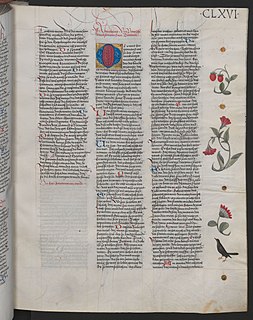
Biterolf und Dietleib is an anonymous Middle High German heroic poem concerning the heroes Biterolf of Toledo and his son Dietleib of Styria. It tells the tale of Biterolf and Dietleib's service at the court of Etzel, king of the Huns, in the course of which the heroes defeat Etzel's enemies, including an extended war/tournament against the Burgundian heroes of the Nibelungenlied. As a reward for their services, Dietleib and Biterolf receive the March of Styria as a fief. The text is characterized by its comedic parody of the traditions of heroic epic.